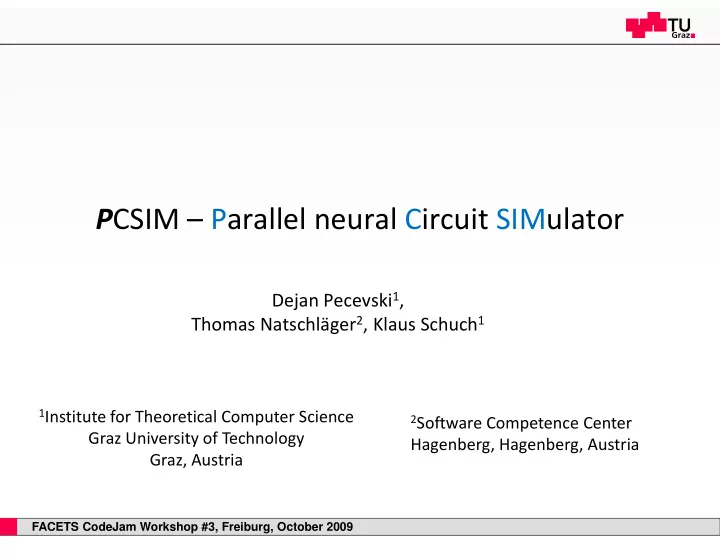

P CSIM – Parallel neural Circuit SIMulator Dejan Pecevski 1 , Thomas Natschläger 2 , Klaus Schuch 1 1 Institute for Theoretical Computer Science 2 Software Competence Center Graz University of Technology Hagenberg, Hagenberg, Austria Graz, Austria FACETS CodeJam Workshop #3, Freiburg, October 2009
Outline PCSIM overview • Bidirectional Python interface • Network construction framework • Basic constructs Basic constructs • Distributed wiring algorithms • • Supported connectivity patterns • Efficiency and scaling FACETS CodeJam Workshop #3, Freiburg, October 2009 2/13
PCSIM – Parallel neural Circuit SIMulator Supports distributed simulation of large spiking and analog neural networks • with point neuron models. Implemented in C++ with a primary interface in Python • there is a new Java interface • Runs under Linux, possible to port on other GNU based systems. • Experimental support for loading NetworkML files • Supports the standardized PyNN interface. • FACETS CodeJam Workshop #3, Freiburg, October 2009 3/13
PCSIM – Parallel neural Circuit SIMulator Ctd. Generic network elements • multiple input and output, spiking and analog ports • suitable for hybrid simulations of spiking and analog elements, • more abstract modules, neuromodulators. FACETS CodeJam Workshop #3, Freiburg, October 2009 4/13
Bidirectional Python Interface: Brian Network in PCSIM class BrianCircuit(PySimObject) : net = SingleThreadNetwork() pycirc = BrianCircuit() def __init__ ( self ): pycirc_id = net.add(pycirc) . . self.registerSpikingOutputPorts(arange(4000)) . self.registerSpikingInputPorts(arange(1000)) net.simulate(2.0) input = PCSIMInputNeuronGroup(1000, self) . . self.brian = brian.Network(input, P, Ce, Ci, Cinp ) Ci, Cinp ) . def reset( self, dt ): . . def advance( self, ai ): . . self.brian.update() self.brian.clock.tick() . . FACETS CodeJam Workshop #3, Freiburg, October 2009 5/13
Network Construction: Creating Neurons FACETS CodeJam Workshop #3, Freiburg, October 2009 6/13
Network Construction: Creating Connections FACETS CodeJam Workshop #3, Freiburg, October 2009 7/13
Distributed Wiring Algorithms Different types of connectivity patterns available • Random – decision whether to make a connection sampled from a Bernoulli • Distribution Degree based - the input/output degree of neurons is sampled from a arbitrary • random distribution Predicate based - independently deciding for each pair of neurons whether to • connect them, probabilistically, based on their attributes Example : creating patchy long -range lateral connections of V1 neurons (Buzas et al. Example : creating patchy long -range lateral connections of V1 neurons (Buzas et al. • • 2006) The probability to connect neurons i and j is • where l i and l j are the lateral coordinates, φ i and φ j are the orientation preferences of neurons i and j and C , κ , σ are parameters. FACETS CodeJam Workshop #3, Freiburg, October 2009 8/13
Three Levels of the Wiring Algorithms FACETS CodeJam Workshop #3, Freiburg, October 2009 9/13
Wiring Methods distributed synchronized • Each node creates both its outgoing and incoming connections. • no MPI communication • A pair of nodes use the same RNG seeds when creating connections • between them in order to synchronize. distributed all-to-all exchange • Each node creates its incoming connections. • Created connections are communicated through MPI. • FACETS CodeJam Workshop #3, Freiburg, October 2009 10/13
Distributed Wiring Algorithms: Scalability We measured the construction time of a model where the number of used nodes • increase proportionally with the number of neurons. In the performed experiments there are • 6000 neurons per node • on average 10000 input connections per neuron for all wiring algorithms • Wiring methods tested: • Distributed Synchronized • Distributed All-To-All Exchange • Wiring algorithms tested: • random • degree – each neuron has exactly 10000 input connections • predicate – distance dependent connection probability • FACETS CodeJam Workshop #3, Freiburg, October 2009 11/13
Measured Construction Time FACETS CodeJam Workshop #3, Freiburg, October 2009 12/13
If you want to try out PCSIM The home page is: http://www.igi.tugraz.at/pcsim • User manual & examples • Tutorial & exercises • The source is hosted at • http://www.sourceforge.net/projects/pcsim Active mailing list at Sourceforge • Released under GNU Public License • Publication about PCSIM • �������� �������������� ������������ ������������� !���"����������#�����$�������$�#����%$���������� ���������%���&������������'�����&��$�(� ������������������� )!**( FACETS CodeJam Workshop #3, Freiburg, October 2009 13/13
Recommend
More recommend